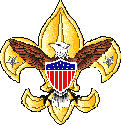| MERIT BADGES |
|
|
|
|
| Note: Eagle Required are in Italics |
"A"
American
Business
American Culture
American Heritage
American Labor
Animal Science
Archaeology
Archery
Architecture
Art
Astronomy
Athletics
Atomic Energy
Auto Mechanics
Aviation
"B"
Backpacking
Basketry
Bird Study
Bugling
"C"
Camping
Canoeing
Chemistry
Cinematography
Citizenship
Community*
Citizenship Nation*
Citizenship World*
Climbing
Coin Collecting
Collections
Communications*
Computers
Cooking
Crime Prevention
Cycling*
"D"
Dentistry
Disability Awareness
Dog Care
Drafting
"E"
Electricity
Electronics
Emergency
Preparedness**
Energy
Engineering
Entrepreneurship
Environmental
Science*
"F"
Family Life*
Farm Mechanics
Fingerprinting
Fire Safety
First Aid*
Fish & Wildlife Mgmt.
Fishing
Fly Fishing
Forestry
"G"
Gardening
Genealogy
Geology
Golf
Graphic Arts
"H"
Hiking
Home Repairs
Horsemanship
"I"
Indian Lore
Insect Studies
"J"
Journalism
"K"
"L"
Landscape Architecture
Law
Leatherwork
Lifesaving**
"M"
Mammal Study
Medicine
Metalwork
Model Design & Building
Motorboating
Music
"N"
Nature
"O"
Oceanography
Orienteering
"P"
Painting
Personal Fitness**
Personal Management*
Pets
Photography
Pioneering
Plant Science
Plumbing
Pottery
Public Health
Public Speaking
Pulp and Paper
"Q"
"R"
Radio
Railroading
Reading
Reptile & Amphibian Study
Rifle Shooting
Rowing
"S"
Safety
Salesmanship
Scholarship
Sculpture
Shotgun Shooting
Skating
Skiing
Small Boat Sailing
Soil & Water
Conservation
Space Exploration
Sports**
Stamp Collecting
Surveying
Swimming**
"T"
Textile
Theatre
Traffic Safety
Truck Transportation
"U"
"V"
Veterinary Medicine
"W"
Water Skiing
Weather
Whitewater
Wilderness Survival
Wood Carving
Woodwork
"X"
"Y"
"Z"
|
|
- Describe the identifying characteristics of six species of reptiles and four species of amphibians found in the United States. For any four of these, make sketches from your own observations or take photographs. Show markings, color patterns, or other characteristics that are important in the identification of each of the four species. Discuss the habits and habitats of all ten species.
- Discuss with your merit badge counselor the approximate number of species and general geographic distribution of reptiles and amphibians in the United States. Prepare a list of the most common species found in your local area or state.
- Describe the main differences between
- Amphibians and reptiles
- Alligators and crocodiles
- Toads and frogs
- Salamanders and lizards
- Snakes and lizards
- Explain how reptiles and amphibians are an important component of the natural environment. List four species that are officially protected by the federal government or by the state you live in, and tell why each is protected. List three species of reptiles and three species of amphibians found in your local area that are not protected. Discuss the food habits of all ten species.
- Describe how reptiles and amphibians reproduce.
- From observation, describe how snakes move forward. Describe the functions of the muscles, ribs, and belly plates.
- Describe in detail six venomous snakes and the one venomous lizard found in the United States. Describe their habits and geographic range. Tell what you should do in case of a bite by a venomous species.
- Maintain one or more reptiles or amphibians for at least a month. Record the food accepted, eating methods, changes in coloration, shedding of skins, and general habits; or keep the eggs of a reptile from the time of laying until hatching; or keep the eggs of an amphibian from the time of laying until their transformation into tadpoles (frogs) or larvae (salamanders).
- Do TWO of the following:
- Identify at night three kinds of toads or frogs by their voices. Imitate the song of each for your counselor. Stalk each with a flashlight and discover how each sings and from where.
- Find and identify (by sight) eight species of reptiles or amphibians.
- Give a brief talk to a small group on the subject of reptiles and amphibians. Use at least three living specimens you have collected.
- Give five superstitions about reptiles and amphibians and a correct explanation for each. Give seven examples of unusual behavior or other true facts about reptiles and amphibians.
NOTE: Scouts must not use venomous reptiles in fulfilling
requirements 8 and 9. Species listed by federal or state law as endangered, protected, or
threatened must not be used as live specimens in completing requirements 8 or 9c unless
official permission had been given. In most cases all specimens should be returned to the
wild at the location of original capture after the requirements have been met. Check with
your merit badge counselor for those instances where the return of these specimens would
not be appropriate.
|
||||||
Last Update May 15, 2023

.jpg)

 Reptile & Amphibian Study
Reptile & Amphibian Study